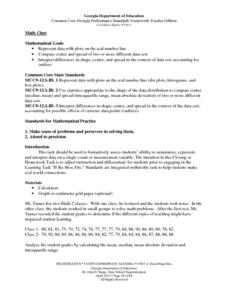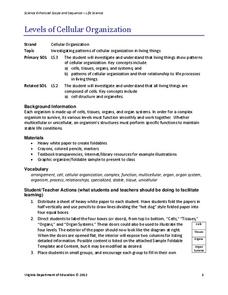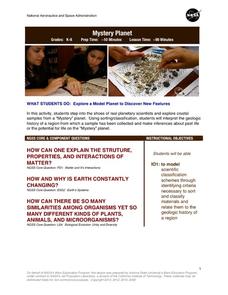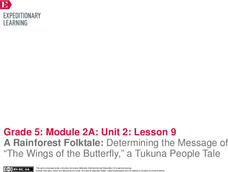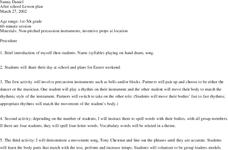Code.org
Event-Driven Programming and Debugging
Start programming in event-driven style. Scholars learn to place buttons on the user interface and use event handlers. They also learn to recognize errors in code and debug as necessary. This is the second lesson in the series of 21.
Illustrative Mathematics
Shape Sequence Search
Learning that size and orientation don't affect the classification of shapes is a big step for young mathematicians. Support children with developing this key understanding by looking at the array of shapes included in this resource. For...
University of Northern Iowa
Clothing
As part of an investigation of the folk traditions of their area, class members research the articles of clothing worn at earlier times, the fibers and materials, and the machinery used to produce these items. In addition, class members...
California Department of Education
An Online Tool I Can Use
Tools for school—and beyond! Introduce your sixth graders to online tools to plan their academic and professional futures. The fifth and final lesson in a series of career and college readiness activities focuses on a scavenger hunt to...
Curated OER
Exploring the Sky: Reading Maria's Comet
Discover the science behind astronomy. After reading the book Maria's Comet, which is about a young woman who breaks new ground by becoming a female astronomer, young learners practice reading comprehension with worksheet questions about...
Georgia Department of Education
Math Class
Young analysts use real (provided) data from a class's test scores to practice using statistical tools. Not only do learners calculate measures of center and spread (including mean, median, deviation, and IQ range), but also use this...
Novelinks
The House on Mango Street: Vocabulary Word Squares
Chanclas, muerto, cuando. Spanish words are plentiful in The House on Mango Street and may be unfamiliar to many readers. A vocabulary words squares activity will help kids remember the meaning of these words and add to their...
The New York Times
Writing to Explain: Creating How-To Scripts and Demonstrations
Excuse me, can you give me directions? Scholars examine and practice technical writing to increase their ability to write directions. They participate in discussion, watch videos, and complete an assignment to create their own directions.
Nemours KidsHealth
Stress: Grades 3-5
Two activities focus on stress—common stressors and coping strategies. In the first activity, scholars identify stressors and explore ways to keep stress away. To aid the process, learners create a poster and complete a handout...
Workforce Solutions
Workforce Solutions K-1 Lessons
Three lessons and one at-home connection explore 12 professions. In the first lesson, scholars examine an online map that displays all 12 careers alongside a video. Lesson two challenges class members to choose two of those careers to...
Overcoming Obstacles
Problem Solving on the Job
The truth is there are consequences for actions. The third instructional activity in the "Problem Solving Module" asks class members to brainstorm a list of problems, select one and invent a system, process, or object that might solve...
Virginia Department of Education
Levels of Cellular Organization
What an eccentric way to learn about each level of cellular organization! Allow emerging biologists to utilize white paper and create their own foldable charts to describe each level of organization in the body. You may also adapt the...
Council for Economic Education
GDP Data: Is the Economy Healthy?
Does the economy needs a check-up? Scholars analyze the gross domestic product (GDP) to determine the overall health of the current economy. They use a short video clip as well as economic data to determine the current growth of the...
Anti-Defamation League
Role Models and Stereotypes: Misty Copeland's Story
A lesson points the spotlight at Misty Copeland, the first African American Principal Dancer. A thoughtful discussion prompts pupils to think of their career aspirations and identify ways role models and stereotypes influence young...
Anti-Defamation League
Emojis and Me
A lesson features the work of O'Plérou Grebet, a graphic designer who created a collection of emojis to represent his life in West Africa. Scholars explore the history and purpose of emojis, then read and discuss an article about...
NASA
Mystery Planet
What can one learn about a planet based on a small surface sample? Learners will explore artifacts from a mystery planet and see what they can determine about the planet based on the evidence in front of them.
National Literacy Trust
Mark The Bard!
Commemorate the 400th anniversary of Shakespeare's death with a packet of cross-curricular literacy lessons and activities centered around two of the Bard's most popular plays, Macbeth and The Tempest. Class members look for evidence of...
US Institute of Peace
What Does It Take to be a Peacebuilder?
In a world of conflict, choose to be a peacebuilder. Young scholars research a chosen peacebuilder from the past or present before creating a billboard project with that person's name, accomplishments, and prominent quotes.
EngageNY
Forming a Research-Based Claim: Stakeholder Chart on Better Industrial Water Management
It's time to stake a claim! Working with partners, scholars create stakeholder charts for better industrial management of water. As they complete the chart, pupils consider an option for managing water more sustainably, identify...
EngageNY
A Rainforest Folktale: Determining the Message of “The Wings of the Butterfly,” a Tukuna People Tale
Did you the message? Scholars listen to a read aloud of The Wings of the Butterfly to summarize and determine the message of the text. They discuss the folktale and vocabulary in groups, then use a double bubble map to compare the story...
Nebraska Department of Education
Communication Skills
It's not just what you say but how you say it! That's the take-away from a lesson about verbal and non-verbal communication. An engaging activity has middle schoolers demonstrating how tone of voice and body language can totally change...
Curated OER
Furniture Defined
Learners dissect and evaluate traditional definitions of furniture styles. For this furniture characteristics lesson, student learn to classify different styles and types of furniture. Students create furniture sketches.
Curated OER
Hula How?
Third graders start writing papers with much more regularity than they did in the previous grades. They are starting to differentiate between the styles of writing and know why each is important. This activity gives the them a chance to...
Curated OER
Movement
Young scholars experiment and explore a variety of instruments and movements. They play rhythms on instruments, spell words using their bodies, act out the movements of a song, role-play machine parts as a group, pantomime an activity,...







